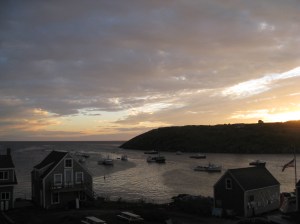Laux, E. Vernon. Bird News: Vagrants and Visitors on a Peculiar Island. Four Walls Eight Windows, 1999.
Reason read: Massachusetts ratified the U.S. Constitution in the month of February. I also needed a book with a bird on the cover for the Portland Public Library Reading Challenge of 2024.
Whether it be off the coast of Massachusetts or Maine, any time on an island is fantastic.
Beyond looking for migratory birds, Laux wants the reader to find a peeper in spring or listen to the sounds of a timberdoodle (whatever that is). His love of nature is apparent on every page, but to be fair, he could get a little preachy at times. He admonished people to not bring their dogs to the beach for fear of stressing out the plover population.
An interesting addition to Bird News is the mini biography of Roger Peterson after his death. The name might sound familiar if you have ever picked up a field guide to birds. Peterson’s illustrations were paramount to identifying a wide variety of birds.
Laux always referred to himself as “this writer” except for one time when he wrote about birding with his son. Was the pronoun ‘I’ a slip of the pen?
Confessional: I could only digest Bird News a few pages at a time. Arranged in loose chronological order by day (but not year), Bird News is a journal of all the bird sightings made by various people on the Cape, Nantucket, and Martha’s Vineyard. The entries become a little repetitious after five or six pages because the compilation was originally written for a column for a local newspaper. Laux had a hotline for people to report the birds they saw. As an aside, I am sure people enjoyed seeing themselves named in print after they called in a bird sighting.
All in all, I enjoyed Bird News. It got me thinking about the lives (and deaths) of our feathered friends. How bad weather can be good for birding especially during migration seasons. The cycle of breeding once spring migration is over. What to do if you find an abandoned baby bird.
Interesting fact: Laux uses the phrase, “inquiring minds want to know” and it sounded super familiar so I did some research to jog my memory. The original phrase was “Enquiring” and it was used in a television ad in the 1980s to drum up readers for the National Enquirer.
Another interesting fact: worm-eating warblers have the highest density in a place I frequently hike. That was cool to learn.
Lines I liked. None. According to the copyright I need to seek permission, even for a review. I can tell you this: I appreciated that Laux quoted a wide range of literary greats like Emerson, Shakespeare, Frost, Welty, Dickinson, Rilke, Browning, Eliot, and Rossetti.
Author fact: Laux reminded me of Natalie Merchant. She remembered her singing coach. Laux thanked an eighth grade science teacher who sparked the interest in nature.
Book trivia: I would have expected more illustrations or even photographs of New England migratory birds, but Bird News is curiously devoid of any except three black and whites of a Tufted Titmouse, a Black-Capped Chickadee and a chickmouse. Once I got to the end of the book I understood why these three birds were so important to Laux. A chickmouse is a hybrid Chickadee and Titmouse. I thought it would be better if they named it a Titadee.
Nancy said: I don’t know Martha’s Vineyard or Nantucket to know exactly what Pearl is talking about in her comments about Bird News.
BookLust Twist: from Book Lust To Go in the chapter called “Martha’s Vineyard” (p 141).

